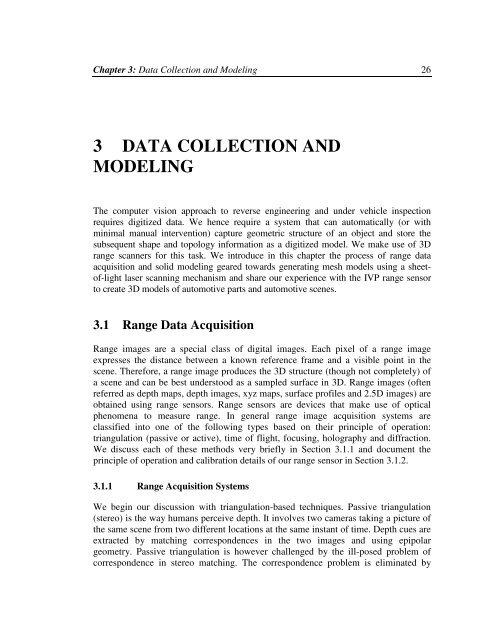To the Graduate Council: I am submitting herewith a thesis written by ...
To the Graduate Council: I am submitting herewith a thesis written by ...
To the Graduate Council: I am submitting herewith a thesis written by ...
Create successful ePaper yourself
Turn your PDF publications into a flip-book with our unique Google optimized e-Paper software.
Chapter 3: Data Collection and Modeling 263 DATA COLLECTION ANDMODELINGThe computer vision approach to reverse engineering and under vehicle inspectionrequires digitized data. We hence require a system that can automatically (or withminimal manual intervention) capture geometric structure of an object and store <strong>the</strong>subsequent shape and topology information as a digitized model. We make use of 3Drange scanners for this task. We introduce in this chapter <strong>the</strong> process of range dataacquisition and solid modeling geared towards generating mesh models using a sheetof-lightlaser scanning mechanism and share our experience with <strong>the</strong> IVP range sensorto create 3D models of automotive parts and automotive scenes.3.1 Range Data AcquisitionRange images are a special class of digital images. Each pixel of a range imageexpresses <strong>the</strong> distance between a known reference fr<strong>am</strong>e and a visible point in <strong>the</strong>scene. Therefore, a range image produces <strong>the</strong> 3D structure (though not completely) ofa scene and can be best understood as a s<strong>am</strong>pled surface in 3D. Range images (oftenreferred as depth maps, depth images, xyz maps, surface profiles and 2.5D images) areobtained using range sensors. Range sensors are devices that make use of opticalphenomena to measure range. In general range image acquisition systems areclassified into one of <strong>the</strong> following types based on <strong>the</strong>ir principle of operation:triangulation (passive or active), time of flight, focusing, holography and diffraction.We discuss each of <strong>the</strong>se methods very briefly in Section 3.1.1 and document <strong>the</strong>principle of operation and calibration details of our range sensor in Section 3.1.2.3.1.1 Range Acquisition SystemsWe begin our discussion with triangulation-based techniques. Passive triangulation(stereo) is <strong>the</strong> way humans perceive depth. It involves two c<strong>am</strong>eras taking a picture of<strong>the</strong> s<strong>am</strong>e scene from two different locations at <strong>the</strong> s<strong>am</strong>e instant of time. Depth cues areextracted <strong>by</strong> matching correspondences in <strong>the</strong> two images and using epipolargeometry. Passive triangulation is however challenged <strong>by</strong> <strong>the</strong> ill-posed problem ofcorrespondence in stereo matching. The correspondence problem is eliminated <strong>by</strong>
















